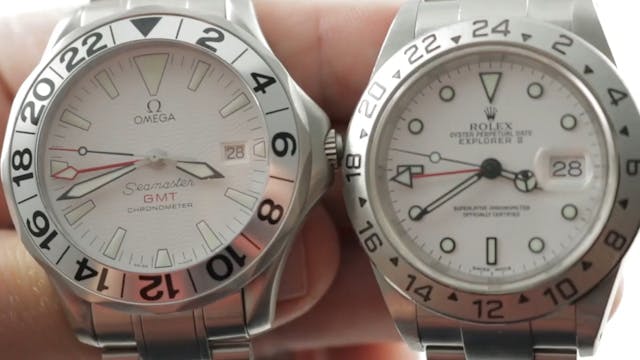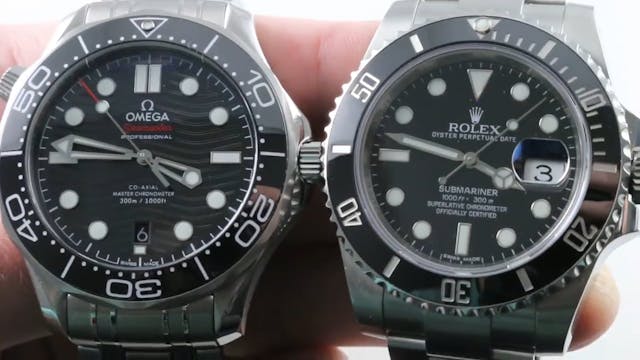Omega Speedmaster Professional 311.30.42.30.01.005 vs Rolex Daytona 116500LN
Versus
•
13m
Rolex vs Omega is the luxury watch industry’s hundred year (or more) war. Rolex, the giant of Geneva, sends its champion, the Rolex Daytona – also known as the “Cosmograph” – into battle with Omega’s eternal icon, the Omega Speedmaster Professional – also known as the “Moonwatch.” Two steel sports chronographs with legendary legacies go head to head today on Versus!
The Rolex Cosmograph Daytona debuted in 1963 after a brief episode in which it was marketed as the Rolex “Le Mans.” Renamed after the new superspeedway at Daytona Beach, Rolex’s chronograph would see crown, caliber, tachymeter and dial variations until the arrival of the 1988 automatic chronometer and its Zenith El Primero movement. The Daytona received a re-design in 2000 with the new Rolex in-house caliber 4130, and that watch became today’s 116500LN courtesy of a Baselworld 2016 ceramic bezel upgrade.
Rolex’s Daytona sports the same 40mm case size and lug profiles introduced 31 years ago. Its Oyster bracelet features a distinctive three-link design, and the Oyster clasp ensures security with double locking clamshell closure. Internally, Rolex Easylink can be deployed for 5mm of tool-free sizing.
Rolex’s current Cosmograph can be ordered with this example’s black dial or a white option; both feature white gold indices and hands, Rolex Chromalight lume, and a triple-register chronograph display with “Daytona” signature at six o’clock. The screw-down chronograph pushers and Triplock crown ensure 100 meter water resistance.
Inside the 904L stainless steel case a Rolex caliber 4130 automatic movement keeps the time. It includes a 72-hour (3-day) power reserve, hacking seconds (stop seconds), a 28,800 beat rate, full balance bridge with a free-sprung index, and COSC Swiss chronometer certification. A Parachrom Blue niobium zirconium Breguet overcoil hairspring adds antimagnetic resistance. Rolex’s 44-jewel 4130 movement features a vertical clutch and column wheel for chronograph actuation.
Omega’s Speedmaster Professional Moonwatch has seen far fewer changes than the Rolex Daytona. Detail revisions to caseback, caliber, dial, and bracelet have characterized the Moonwatch’s journey from the original 1968 reference 145.022 to the current 311.30.42.30.01.005 as launched at Baselworld 2014.
A 42mm asymmetrical stainless steel case, domed Hesalite (thermoplastic) crystal, and anodized aluminum tachymeter bezel have been the external design constants. Omega regularly upgrades the Speedmaster Professional’s bracelet, and the current stainless steel model includes removable links fixed by screws, a trigger-actuated deployant clasp, and solid end links.
Little has changed on the Omega Moonwatch’s dial since the arrival of Super Luminova in the late 1990s. The dial base is matte black in order to defeat glare, all features are printed in white, and the hands are varnished white to maximize contrast. This styling stasis is precisely what NASA – Omega’s VIP client for the Moonwatch – requires. Likewise, the Hesalite crystal has been retained for its shatter resistance in zero-gravity, and the Omega caliber 1861 has been retained for its ruggedness under violent use conditions.
Omega’s caliber 1861 was introduced in 1968 as the caliber 861, and changes since that time amount to details. Modern versions include a rhodium-plated set of brass bridges and plates, 18 jewels, a Delrin chronograph brake, and few other changes from the 1968 model. All versions of the Moonwatch caliber are manual wind with a 48-hour power reserve, beat at a rate of 21,600 vibrations per hour, and include a robust lateral clutch/cam chronograph tandem for shock resistance. Water resistance for this NASA-issued space watch is 50 meters, or exactly 50 meters more water than an Astronaut will encounter on the job.
Omega vs Rolex starts now!
The Omega Speedmaster Moonwatch Professional Chrono is encased in 42mm of stainless steel surrounding a black dial on a stainless steel bracelet. Functions include hours, minutes, seconds, and chronograph. The watch also measures 14.3mm in thickness and 48.5mm from lug-to-lug.
The Rolex Daytona features a 40mm stainless steel case with a black Cerachrom bezel surrounding a black dial on a stainless steel Oyster bracelet with folding buckle. Functions include, hours, minutes, small seconds and chronograph. The watch also measures 12.4mm in thickness and 47mm from lug-to-lug.
Up Next in Versus
-
Rolex Explorer II 16750 vs Omega Seam...
The Omega Seamaster 300M GMT 2538.20.00 is encased in 41 mm of stainless steel surrounding a white wave dial on a stainless steel bracelet. Features include hours, minutes, seconds, date, and GMT function. The watch also measures 13.6 mm in thickness and 47.5 mm from lug-to-lug.
The Rolex Explore... -
2018 Omega Seamaster 210.30.42.20.01....
Rolex Submariner 116610LN vs 2018 Omega Seamaster Diver 300M 210.30.42.20.01.001; it’s the ultimate dive watch comparison! The ageless Rolex Submariner goes head to head with the renewed 25th anniversary Omega Seamaster Professional Diver 300M. Both of these luxury dive watches are stainless stee...
-
Omega Speedmaster CK2998 Moonwatch LE...
The Omega Speedmaster Moonwatch Chronograph CK 2998 Limited Edition Blue (311.33.40.30.02.001) features a 39.7mm stainless steel case surrounding a silver dial on a blue alligator strap with a stainless steel tang buckle. Functions include hours, minutes, seconds, tachymeter and chronograph. The ...



